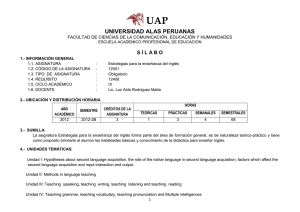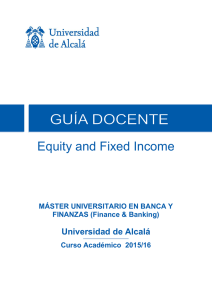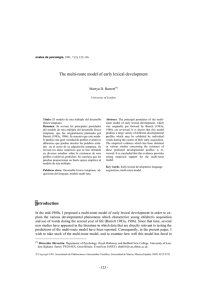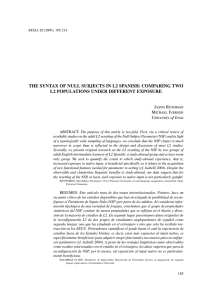S Í L A B O
Anuncio
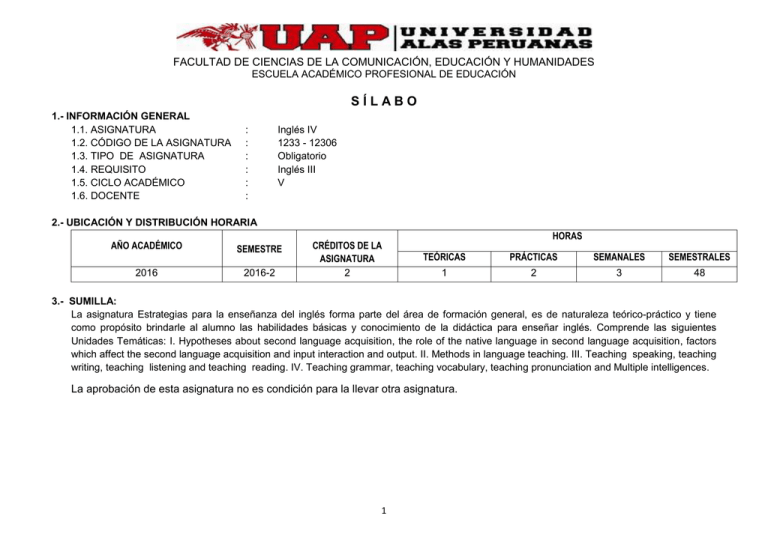
FACULTAD DE CIENCIAS DE LA COMUNICACIÓN, EDUCACIÓN Y HUMANIDADES ESCUELA ACADÉMICO PROFESIONAL DE EDUCACIÓN SÍLABO 1.- INFORMACIÓN GENERAL 1.1. ASIGNATURA 1.2. CÓDIGO DE LA ASIGNATURA 1.3. TIPO DE ASIGNATURA 1.4. REQUISITO 1.5. CICLO ACADÉMICO 1.6. DOCENTE : : : : : : Inglés IV 1233 - 12306 Obligatorio Inglés III V 2.- UBICACIÓN Y DISTRIBUCIÓN HORARIA AÑO ACADÉMICO 2016 SEMESTRE 2016-2 CRÉDITOS DE LA ASIGNATURA 2 HORAS TEÓRICAS PRÁCTICAS SEMANALES SEMESTRALES 1 2 3 48 3.- SUMILLA: La asignatura Estrategias para la enseñanza del inglés forma parte del área de formación general, es de naturaleza teórico-práctico y tiene como propósito brindarle al alumno las habilidades básicas y conocimiento de la didáctica para enseñar inglés. Comprende las siguientes Unidades Temáticas: I. Hypotheses about second language acquisition, the role of the native language in second language acquisition, factors which affect the second language acquisition and input interaction and output. II. Methods in language teaching. III. Teaching speaking, teaching writing, teaching listening and teaching reading. IV. Teaching grammar, teaching vocabulary, teaching pronunciation and Multiple intelligences. La aprobación de esta asignatura no es condición para la llevar otra asignatura. 1 4.- COMPETENCIAS Y CAPACIDADES A DESARROLLAR: COMPETENCIAS Identify the importance of second language acquisition and reflect on the factors which may affect the language acquisition of learners in their particular context. Analyze the methods in English language teaching. Identify the approaches to the teaching of the macro skills of listening, speaking, reading and writing in English language teaching. Identify the approaches to the teaching different aspects in grammar, vocabulary, pronunciationand design a lesson plan. UNIDAD I CAPACIDADES Identify the hypotheses of second language acquisition. Analyze the first language acquisition and compare with second language acquisition. Analyze the factors which affect the second language acquisition. Identify the importance of the input and output. Identify the methods to apply in teaching English. Analyze approaches to teach the productive skills and prepare lesson plans to teach each skill. Analyze approaches to teach the receptive skills and prepare lesson plans to teach each skill. II III IV Recognizeapproaches to teach grammarand prepare lesson plans to teach it. Recognize approaches to teach vocabulary and prepare lesson plans to teach it. Recognize methods, techniques and activities for teaching pronunciation. Analyze the importance of the theory of multiple intelligences. 2 5.- PROGRAMACIÓN DEL PROCESO DE APRENDIZAJE: UNIDAD I EVALUACIÓN CAPACIDADES CONTENIDOS SIGNIFICATIVOS Identify the hypotheses of - Hypotheses about second language acquisition second language acquisition. Analyze the first language - The role of the native language in second language acquisition acquisition and compare with second language acquisition. ESTRATEGIAS METODOLÓGICAS Deductive SEMANA INDICADORES INSTRUMENTOS Do a summary Conceptual map Do exercises Exercises Give the test Test Do exercises Exercises Do a summary Conceptual map I Interrogative II Analyze the factors which - Factors which affect the second Discussion language acquisition. affect the second language acquisition. Input, interaction and output Identify the importance of the Interrogative input and output. LECTURA 1 Acquisition and learning a second language III IV BIBLIOGRAFÍABÁSICA Jeremy Harmer. (2007). The practice of english language teaching with DVD. Fouth edition. Person Logman. David Nunan. (2004). Task based Language Teaching. First Edition. Cambridge University Press. ENLACES DE INTERNET Stephen Krashen on Language Acquisition: http://www.youtube.com/watch?v=NiTsduRreug&feature=related TEMPORALIZACIÓN 3 UNIDAD II EVALUACIÓN CAPACIDADES CONTENIDOS SIGNIFICATIVOS ESTRATEGIAS METODOLÓGICAS Workshop Identify the methods to apply - Methods in languageteaching Grammar translation method in teaching English. The Direct method Methods in languageteaching Workshop Identify the methods to apply Audio lingual method in teaching English. Total physical response Methods in languageteaching Workshop Identify the methods to apply Silent way in teaching English. Suggestopedia Workshop Identify the methods to apply - Methods in languageteaching Natural approach in teaching English. Community language learning Communicative language teaching LECTURA 1 English methods as a second language throught the years SEMANA V VI VII VIII INDICADORES INSTRUMENTOS Teach a lesson using a Model class method Teach a lesson using a method Model class Teach a lesson using a method Model class Teach a lesson using a method Model class Do a summary Conceptual map BIBLIOGRAFÍABÁSICA Jeremy Harmer. (2007). The practice of english language teaching with DVD. Fouth edition. Person Logman. David Nunan. (2004). Task based Language Teaching. First Edition. Cambridge University Press. ENLACES DE INTERNET Language Teaching Methods; Suggestopedia: http://www.youtube.com/watch?v=0g6hyZqrPnY Silent Way ESL class: http://www.youtube.com/watch?v=sshhHFWwukM&feature=related TEMPORALIZACIÓN 4 UNIDAD III EVALUACIÓN CAPACIDADES Analyze approaches to the productive skills prepare lesson plans to each skill. Analyze approaches to the productive skills prepare lesson plans to each skill. Analyze approaches to the receptive skills prepare lesson plans to each skill. Analyze approaches to the receptive skills prepare lesson plans to each skill. LECTURA 1 CONTENIDOS SIGNIFICATIVOS teach and teach - Teachingspeaking ESTRATEGIAS METODOLÓGICAS Workshop SEMANA teach and teach - Teachingwriting Workshop X Design and teach from a lesson plan Model class teach and teach - Teachinglistening Workshop XI Design and teach from a lesson plan Model class teach and teach - Teachingreading Workshop XII Design and teach from a lesson plan Model class Do a summary Conceptual map INDICADORES INSTRUMENTOS IX Design and teach from a lesson plan Model class Language skills BIBLIOGRAFÍABÁSICA Jeremy Harmer. (2007). The practice of english language teaching with DVD. Fouth edition. Person Logman. David Nunan. (2004). Task based Language Teaching. First Edition. Cambridge University Press. ENLACES DE INTERNET Teaching Skills : How to Help Children Who Have No Desire to Learn: http://www.youtube.com/watch?v=_ulAEvx5tUg&feature=related TEMPORALIZACIÓN 5 UNIDAD IV EVALUACIÓN CAPACIDADES CONTENIDOS SIGNIFICATIVOS Recognize approaches to teach grammar and prepare lesson plans to teach it. - Teaching grammar ESTRATEGIAS METODOLÓGICAS Workshop Recognize approaches to teach vocabulary and prepare lesson plans to teach it. - Teaching vocabulary Workshop Recognize methods, techniques and activities for teaching pronunciation. - Teaching pronunciation Workshop BIBLIOGRAFÍABÁSICA ENLACES DE INTERNET XIII XIV XV Analyze the importance of - Multipleintelligences the theory of multiple intelligences. LECTURA 1 Focusing on the language PRODUCTO FINAL SEMANA Discussion INDICADORES Design and teach from a lesson plan INSTRUMENTOS Model class Design and teach from a lesson plan Model class Develop activities for teaching pronunciation. Model class Do a summary Conceptual map Do a summary Conceptual map XVI Create diversity original materials for English teaching language Design and create Original materials materials Jeremy Harmer. (2007). The practice of English language teaching with DVD. Fouth edition. Person Logman. David Nunan. (2004). Task based Language Teaching. First Edition. Cambridge University Press. Full lesson plans: http://www.funlessonplans.com/preschool_lesson_plans/free.htm TEMPORALIZACIÓN 6 6. SISTEMA DE EVALUACIÓN: La evaluación será permanente e integral, reflejando el desarrollo de las capacidades y competencias. Se deberá considerar para promediar las prácticas y exámenes: a) La evaluación mediante las pruebas escritas. b) La evaluación mediante las intervenciones orales en clase, prácticas calificadas, pruebas de ejecución, trabajos individuales y/o grupales, control de las tareas, presentación de cuadernos, fólderes y otros. c) La evaluación mediante fichas de observación del estudiante, su presentación, comportamiento, responsabilidad, respeto, iniciativa y relaciones con sus compañeros. d) Se exige al estudiante como mínimo el 70 % de asistencia regular y continua a clases. Un número de inasistencia mayor al 30 % significará la desaprobación inmediata en la asignatura. e) Forman parte del promedio final de evaluación dos tipos: TIPO DE EVALUACION Nº % 1 PROCESO DE EVALUACIÓN Evaluación Parcial CRITERIOS DE EVALUACIÓN INSTRUMENTOS DE EVALUACIÓN Prueba escrita u otros 2 Evaluación Final 30 Prueba escrita u otros Práctica calificada I Capacidades Actitudes RESPONSABLES Prueba escrita u otros FORMATIVA Y SUMATIVA Docente de Asignatura Práctica calificada II 25 Prueba escrita u otros 20 Trabajos Académicos Intervenciones Producto Final 10 Proyección Social 05 Valoración Crítica del Producto. Participación Lista de cotejo Portafolio. Bitácora. Rúbrica Lista de Cotejo. Ficha de Observación Participación. Ficha de Observación Niveles Lectora Productos Mensuales 3 Extensión Universitaria Proyección Social Extensión Universitaria. 05 Plan Lector Institucional TOTAL 05 100 de 7 Comprensión Lista de cotejo Coordinador del PLAN LECTOR f) Las calificaciones serán de CERO (00) A VEINTE (20), siendo la nota mínima aprobatoria once (11). g) En el promedio final, las fracciones de cinco décimas (0,5) favorecen al estudiante. h) El examen sustitutorio reemplazará a la nota más baja desaprobatoria que el estudiante haya obtenido, del examen parcial o final. 7.- BIBLIOGRAFÍA COMPLEMENTARIA: Jeremy Harmer. 2007. The practice of English language teaching with DVD. Fouth edition. Person Logman. David Numan. 2004. Task-based language teaching. First published. Cambridge University Press. Michael H. Long – Jack Richards. 1987. Methodology in Tesol. First printing. Printed in the U.S.A. 8 8. RÚBRICA PARA EVALUAR PRODUCTO FINAL: PLANTEAMIENTO DEL PROBLEMA DE INVESTIGACIÓN Descriptores PUNTAJE Aspectos EXCELENTE 3 A tiempo real, sin observaciones de limpieza, redacción, ortografía y diseño creativo. BUENO 3 A tiempo real, limpio, sin errores de redacción y ortografía, diseño formal. REGULAR 2 A tiempo real, limpio, sin errores de redacción, pero con faltas de ortografía y diseño formal. Estructura con valor agregado y coherencia lógica entre las partes. Estructura de acuerdo a indicaciones y coherencia lógica Auténtico, inédito, totalmente novedoso en el tema Innovador, el tema es poco tratado en l investigación Estructura de acuerdo a instrucciones, pero se observa desorden en la organización. Los elementos tratan de investigaciones muy conocidas. Porcentaje de contenidos Cubre el 100º % de los elementos de planteamiento Cubre el 90 % de los elementos Cubre el 80 % 5 de los elementos Está por debajo del 80 % 5 de los elementos Relación con la descripción de la realidad El diagnóstico está documentado ampliamente La data es suficiente para representar la realidad problemática Describe estadísticamente un 40 % de la realidad No aporta información suficiente sobre la realidad problemática Presentación Organización Originalidad de contenidos TOTAL 9 DEFICIENTE 1 A tiempo real, pero con defectos de limpieza y notables errores de ortografía, redacción y sin diseño Sin criterio de organización Es copia de otros trabajos de investigación
